This fall, turn your backyard, u-pick, or farmers market apples into fresh-pressed, spontaneously fermented, sparkling apple cider! This recipe couldn’t be easier but the fizzy, sweet-and-tart cider is out of this world!
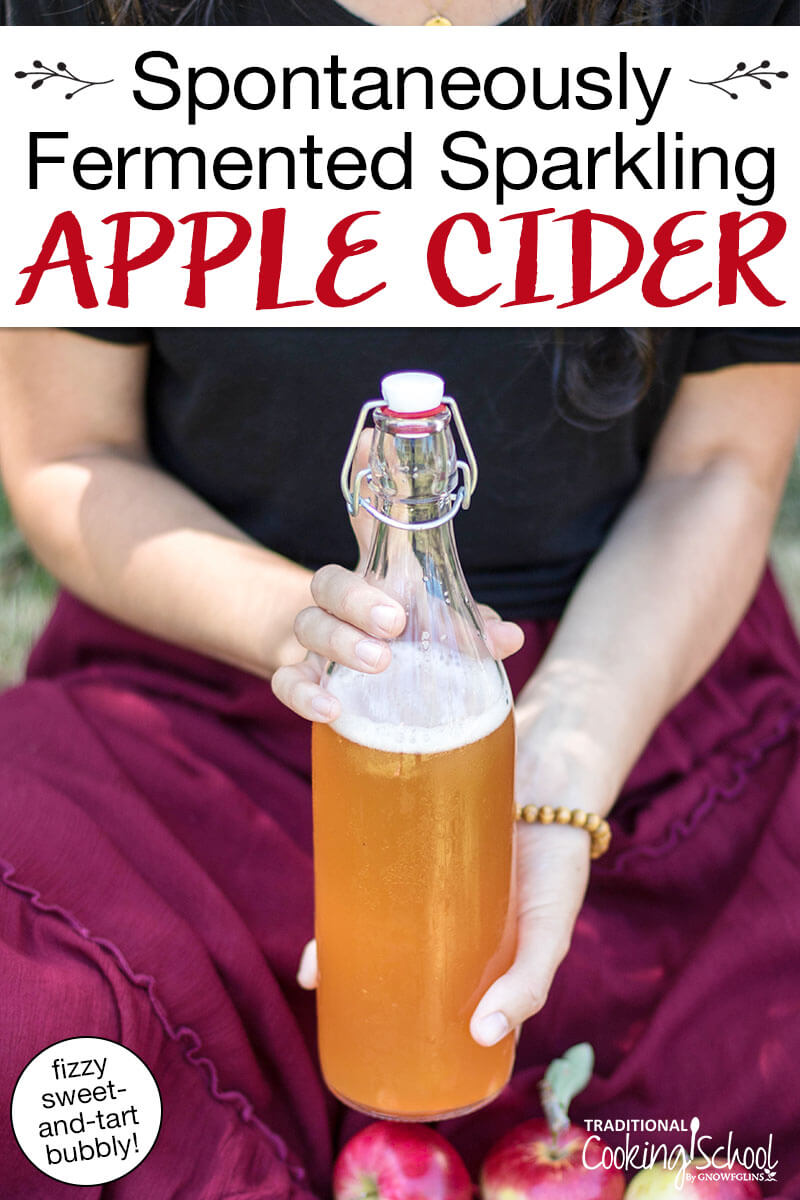
Wherever you live, I want you to get your hands on as many apples as you can…
The uglier the better. 😉
And it’s not to make grain-free apple pie shortbread or chai spiced apple cake or cider donuts. (Though, please feel free to make all of those before fall is over!) It’s because you NEED spontaneously fermented sparkling apple cider in your life. Stat!
Table Of Contents
Why I Love This Recipe
Now, just so we’re clear, this isn’t like those other sparkling apple cider recipes that call for a combination of apple, grape, and/or orange juice plus soda for carbonation. This is the real deal that your great-grandparents might have been making a hundred years ago, with apples picked off their own or a neighbor’s apple tree.
Spontaneously fermented sparkling apple cider can hardly be called a recipe. After all, it’s just one ingredient — freshly pressed apple cider.
The skin of unwashed, organic apples is teeming with microscopic organisms — tiny yeasts and bacteria that feed off the natural sugars in apple cider and turn it into a bubbly, sparkling, sweet-and-tart glass of fall flavor! No need to add sugar or spices!
When those dark, cold winter days blow in… And when those yucky, wet spring days seem to drag on forever… You’ll be so thankful that you bottled up the best of the fall harvest — apples!
Apple Cider Or Apple Juice… Which Is It?
Is there a difference between apple cider and apple juice? You bet there is!
Real apple cider is made from freshly pressed (or juiced) apples and is not filtered. So, when you’re fermenting your cider, you should see bits of brown sediment settling at the bottom of your jars or bottles.
On the other hand, apple juice starts as cider. Then it’s filtered and concentrated. Water is added back to it, and then it is pasteurized to be shelf-stable.
You CANNOT use pasteurized, bottled apple “cider” or juice from the grocery store for this process. It will not work. Furthermore, if you purchase any sort of shelf-stable product labeled “apple cider”, especially if sweeteners, spices, or flavors have been added, it is not real cider at all!
Traditional cider is raw and unfiltered. Once fermented to suit your tastes, it must be stored in the refrigerator or a very cold root cellar. To save refrigerator space, I have a friend who water bath cans her cider. Of course, it’s no longer raw or fermented after this, but it does remain unfiltered and is shelf-stable cider.
Now that we’ve got that cleared up… let’s ferment some cider!
Ingredients
- Apples — Choose organic so that the herbicides and pesticides on conventional apples don’t interfere with fermentation. It’s even better if the apples are locally grown. If organic from a local source you trust (your neighbor’s tree, a nearby orchard, etc.) you don’t even need to wash the apples, and it’s better not to so you don’t wash away the beneficial microorganisms that will kickstart fermentation!
Supplies Needed
- A cider press or juicer — Follow the specific instructions below depending on which option you choose!
- Swing-top bottles or quart-sized Mason jars — Either will work, but swing-top bottles ensure better carbonation.
How to Make Sparkling Apple Cider
By doing large batches of spontaneously fermented sparkling apple cider, you can enjoy this quintessential fall ferment throughout winter and spring!
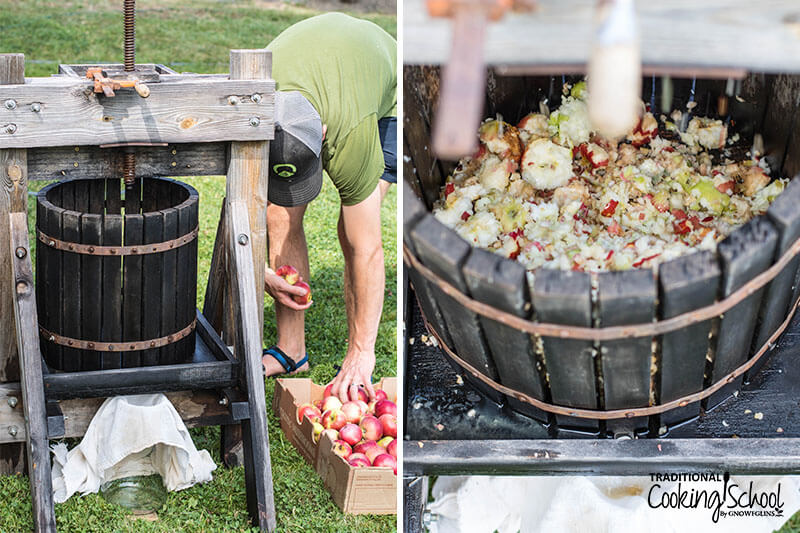
Using a cider press…
- Press the apples — skin, stems, peels, and all! This means adding apples a few at a time to the grinding box where the blade is. The apple pieces or pulp will then fall into the tub (the part that looks like a barrel).
- Once the tub is full, position the pressing plate that looks like a lid but actually fits inside the tub like a round plate. As you screw it tighter down into the tub, it squeezes the cider out of the apple pulp into the jar below!
- You don’t have to worry about stray leaves or sticks because they’ll be filtered out (as you can see in the photos, the tub catches most of the debris, but I also cover my jar with a layer of cheesecloth just in case). As long as you’re sure your apples are organic and have never been sprayed with anything, you don’t even need to wash them first!
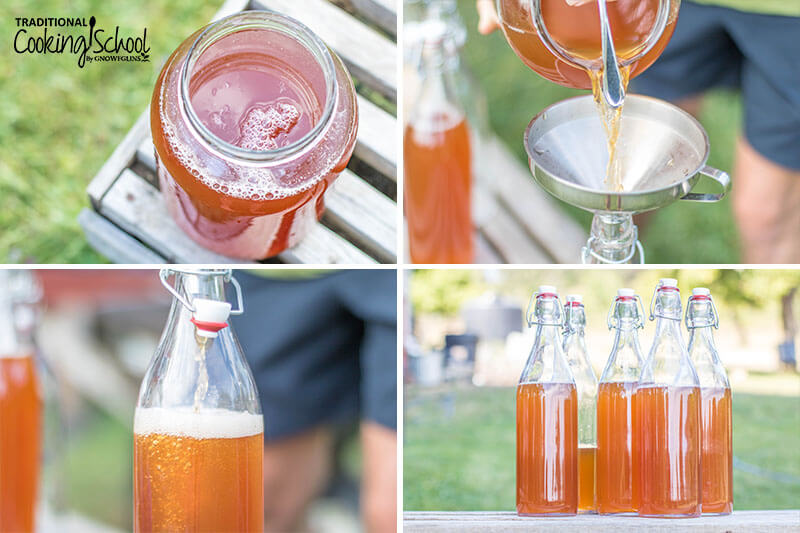
- Transfer the fresh-pressed cider to swing-top bottles or quart-sized jars and close.
- Leave to ferment at room temperature for 2 to 4 days. You can go longer, but the cider will lose most of its sweetness and become slightly alcoholic the longer it ferments.
- Make sure to check and “burp” your jars at least once a day! This means opening each bottle to release the pent-up gases to prevent explosions. As the yeasts and bacteria get to work eating the apple’s sugar, they’ll begin to release carbon dioxide, especially by the end of the second day.
- Once the apple cider tastes like you want and has the fizz (sparkle!) you like, transfer it to the refrigerator.
Using a juicer…
- Remove leaves and sticks, but don’t worry about the skins, stems, and peels.
- Juice according to your juicer’s instructions.
- Transfer the fresh-pressed cider to swing-top bottles or quart-sized jars and close.
- Leave to ferment at room temperature for 2 to 4 days. You can go longer, but the cider will lose most of its sweetness and become slightly alcoholic the longer it ferments.
- Make sure to check and “burp” your jars at least once a day! This means opening each bottle to release the pent-up gases to prevent explosions. As the yeasts and bacteria get to work eating the apple’s sugar, they’ll begin to release carbon dioxide, especially by the end of the second day.
- Once the apple cider tastes like you want and has the fizz (sparkle!) you like, transfer it to the refrigerator.
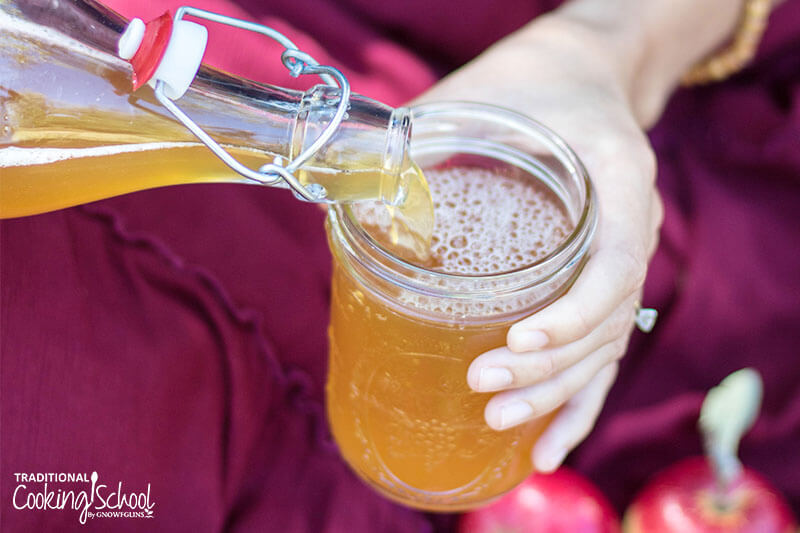
Recipe Tips & FAQs
You can compost your apple scraps, feed them to your animals, or turn them into homemade apple cider vinegar!
If you have any other questions, check out our guide to fermentation troubleshooting to see if it has been answered there!
Other Naturally Fermented Recipes
Sparkling apple cider may be fall’s easiest ferment… but it’s just the beginning of what’s possible through lacto-fermentation! Check out our free Fermenting archives here at TCS, and enjoy some of our favorite recipes, below…
- Honey-Sweetened Ginger Beer {probiotic, non-alcoholic, GAPS-friendly natural soda!}
- The ULTIMATE Water Kefir Guide (how to make it, store it, flavor it, brewing tips & MORE!)
- The ULTIMATE Kombucha Guide {how to make it, store it, flavor it, SCOBY care, troubleshooting, and MORE!}
- 5-Spice Apple Chutney {lacto-fermented!}
- Fizzy Apple Cider Switchel (VAD)
- Homemade Raw Apple Cider Vinegar Recipe
- 5-Minute Probiotic Mixed Berry Switchel {paleo, GAPS, AIP}
- How To Make Beet Kvass
Did you make this sparkling apple cider recipe? If so, please give us a rating on the recipe card below. Then snap a photo and tag us on social media so we can see how you enjoyed it!
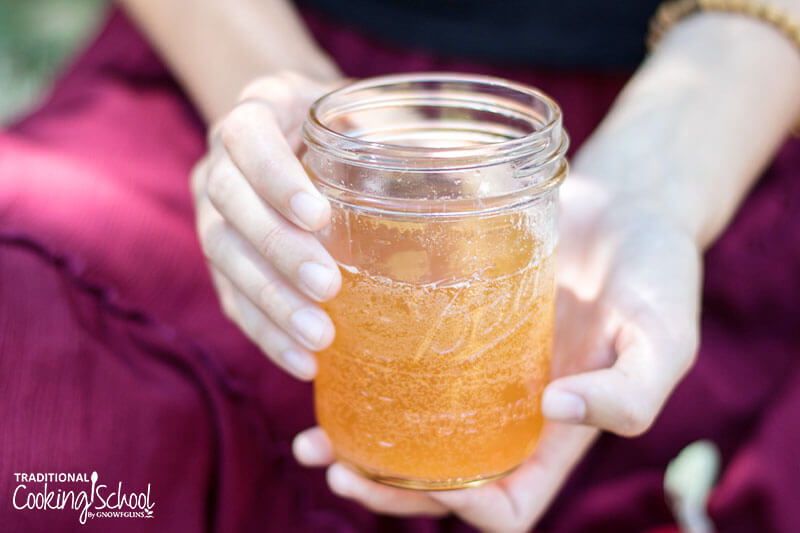
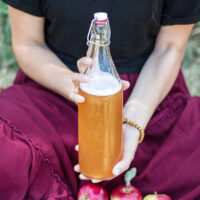
Sparkling Apple Cider Recipe
This fall, turn your backyard, u-pick, or farmers market apples into fresh-pressed, spontaneously fermented, sparkling apple cider! This recipe couldn't be easier but the fizzy, sweet-and-tart cider is out of this world! No need to add sugar or spices!
Ingredients
- apples locally grown, if possible
- a juicer We use a neighbor's cider crusher/press, but you can totally do this without one!
- swing-top bottles and/or quart-size Mason jars
Instructions
First, juice (or press) the apples -- skin, stems, peels, and all!
-
If you're using a cider press, you don't even have to worry about stray leaves or sticks because they'll be filtered out. As long as you're sure your apples are organic and have never been sprayed with anything, you don't even need to wash them first!
-
If you're using a juicer, remove leaves and sticks before juicing, but don't worry about the skins, stems, or peels. Whether using a cider press or juicer, there won't be any leaves, seeds, or stems in the finished cider.
Transfer...
-
the fresh-pressed cider to swing-top bottles or quart-size jars and close. Leave on your countertop for 2 to 4 days. (You can go longer, but the cider will lose most of its sweetness and become slightly alcoholic the longer it ferments.)
-
As the yeasts and bacteria get to work eating the apple's sugar, they'll begin to release carbon dioxide, especially by the end of the second day. Make sure to check and burp your jars at least once a day! Once the apple cider tastes like you want and has the fizz (sparkle!) you like, transfer it to the refrigerator.
Recipe Notes
- Traditional cider is raw and unfiltered. Once fermented to suit your tastes, it must be stored in the refrigerator or a very cold root cellar.
We only recommend products and services we wholeheartedly endorse. This post may contain special links through which we earn a small commission if you make a purchase (though your price is the same).
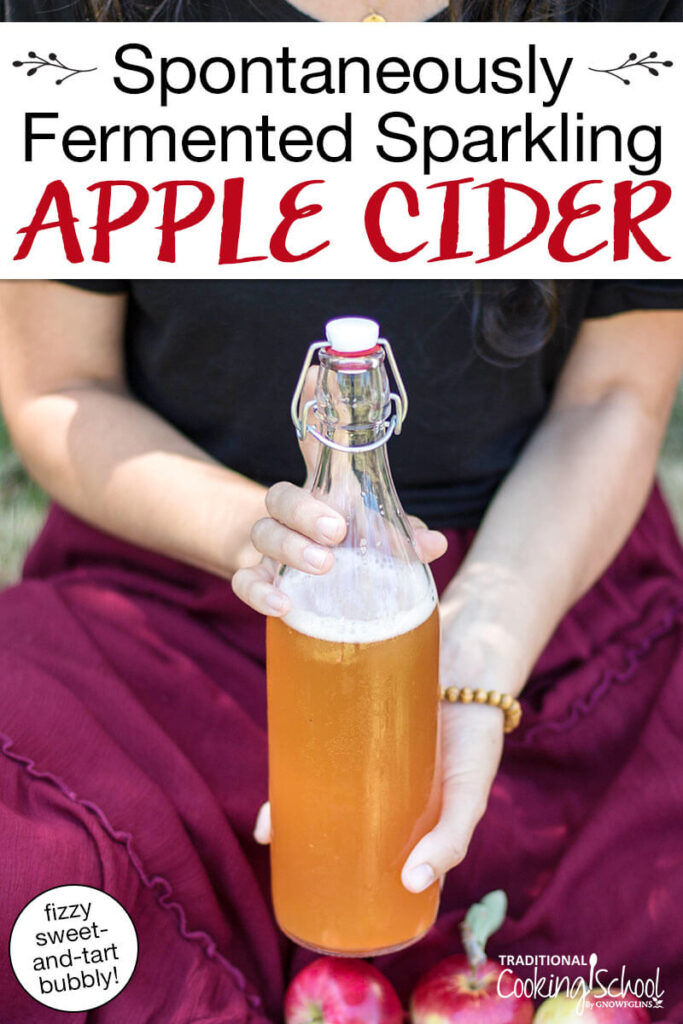
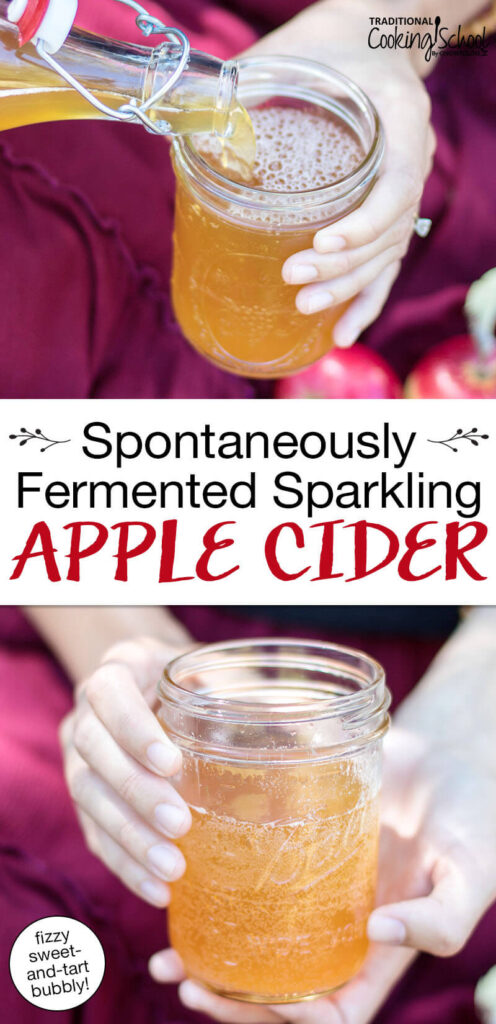

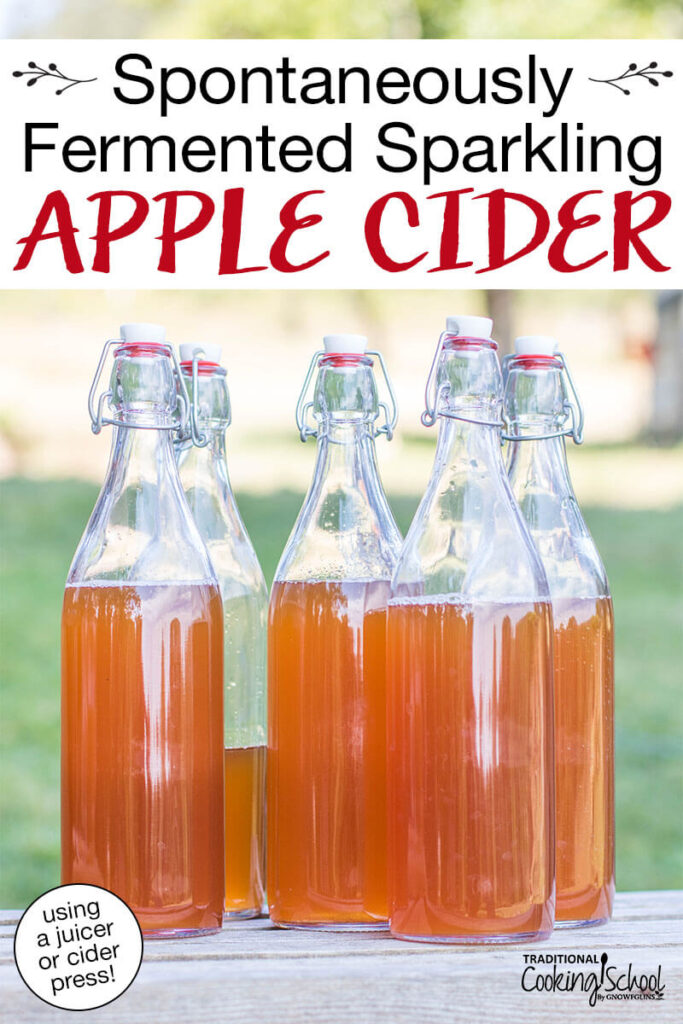
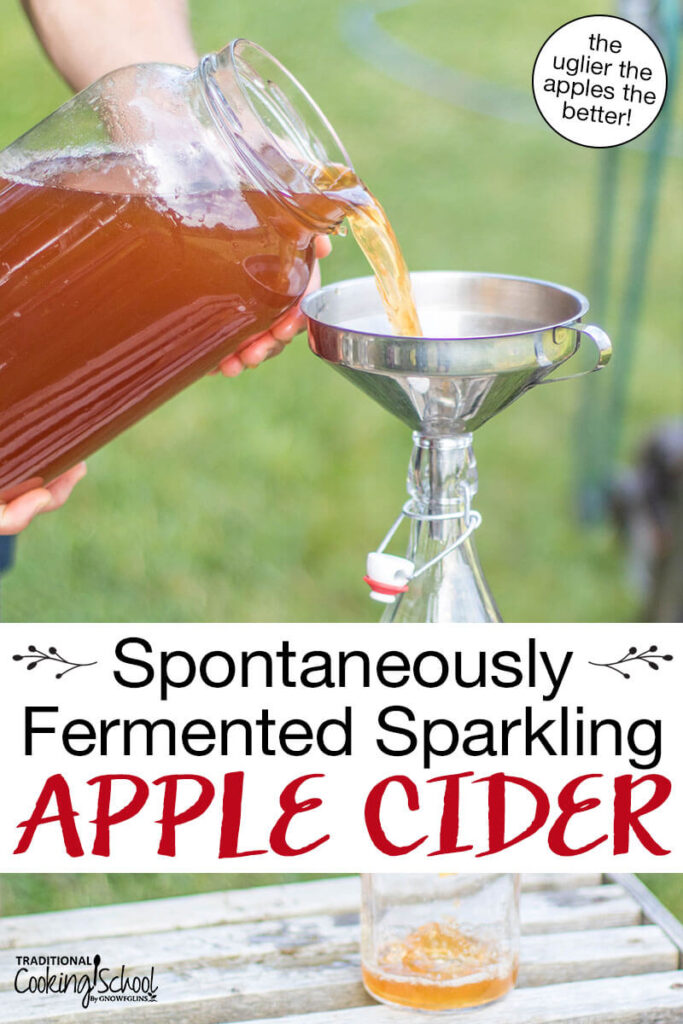
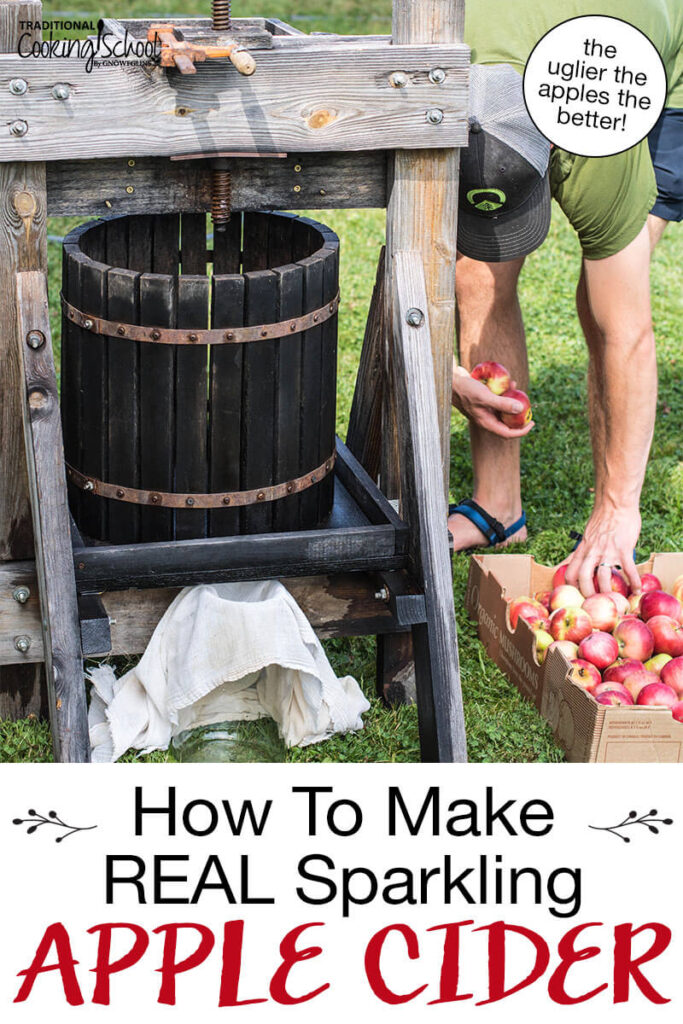
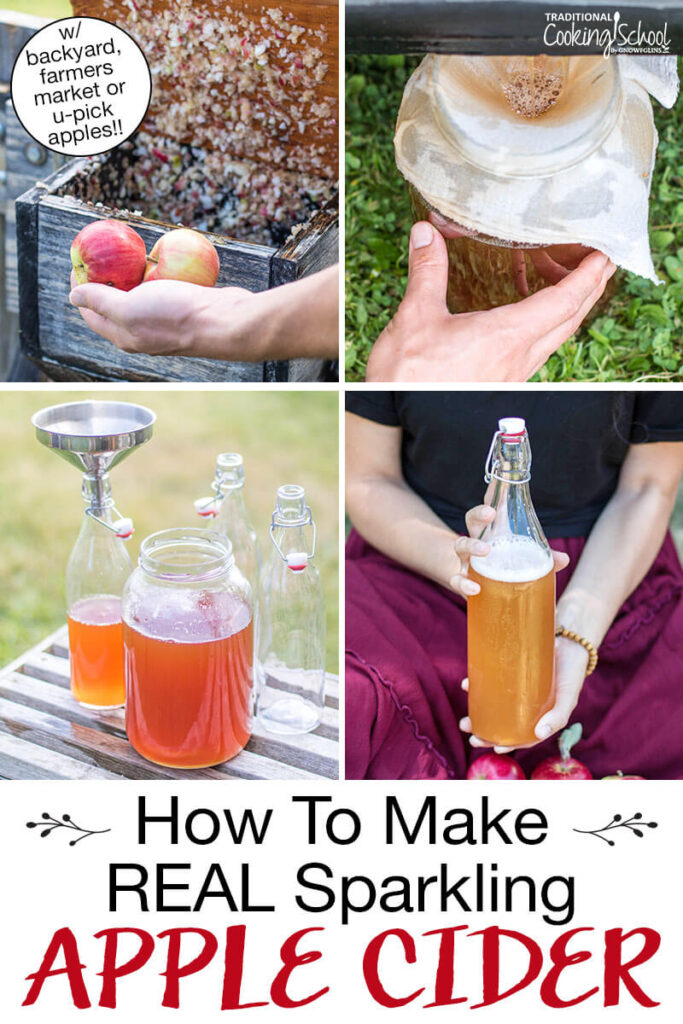
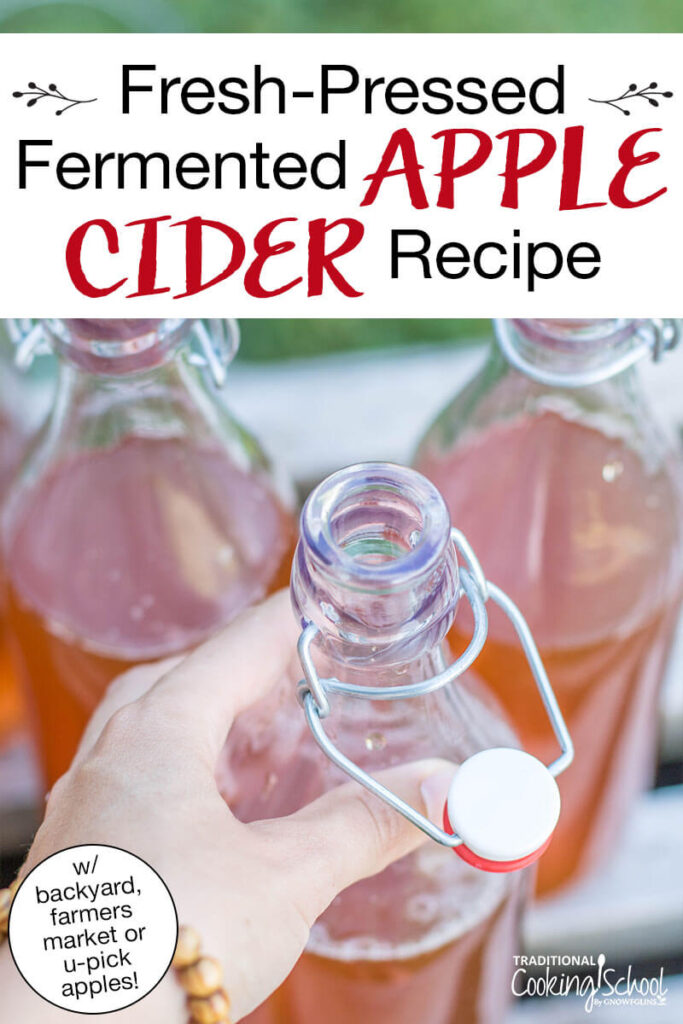
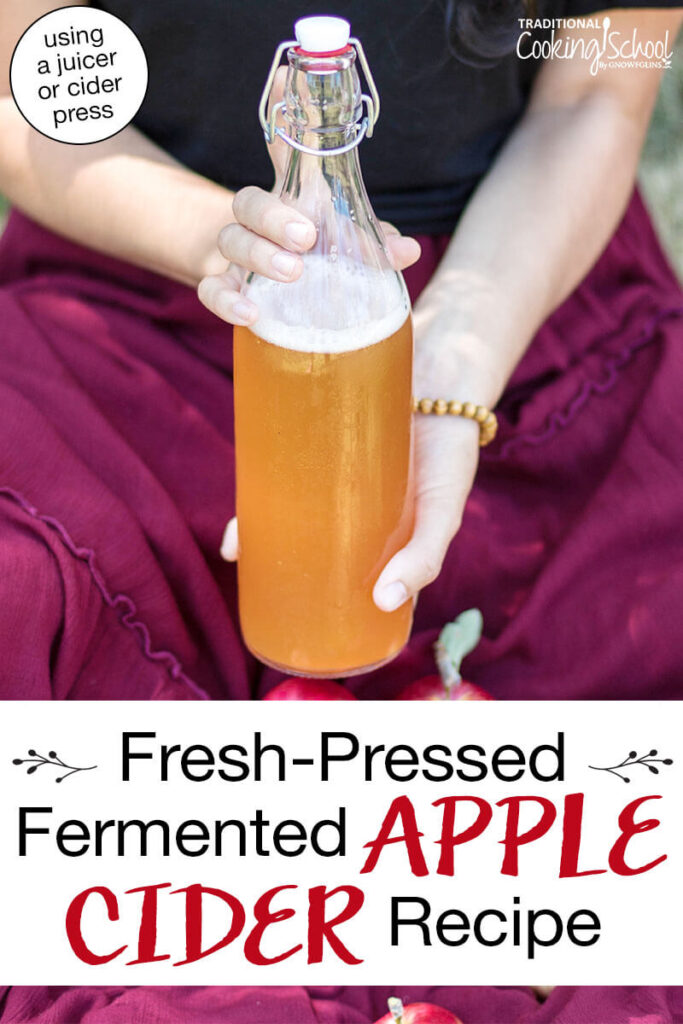
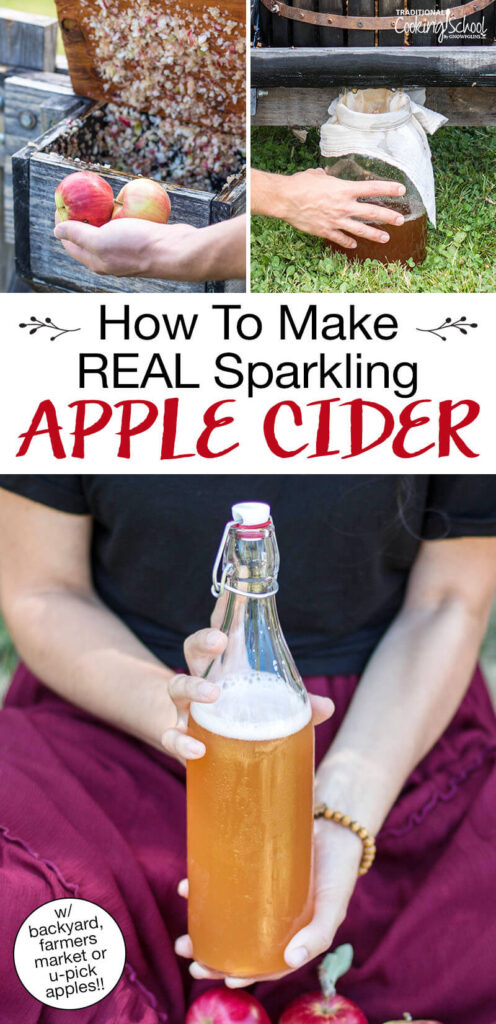
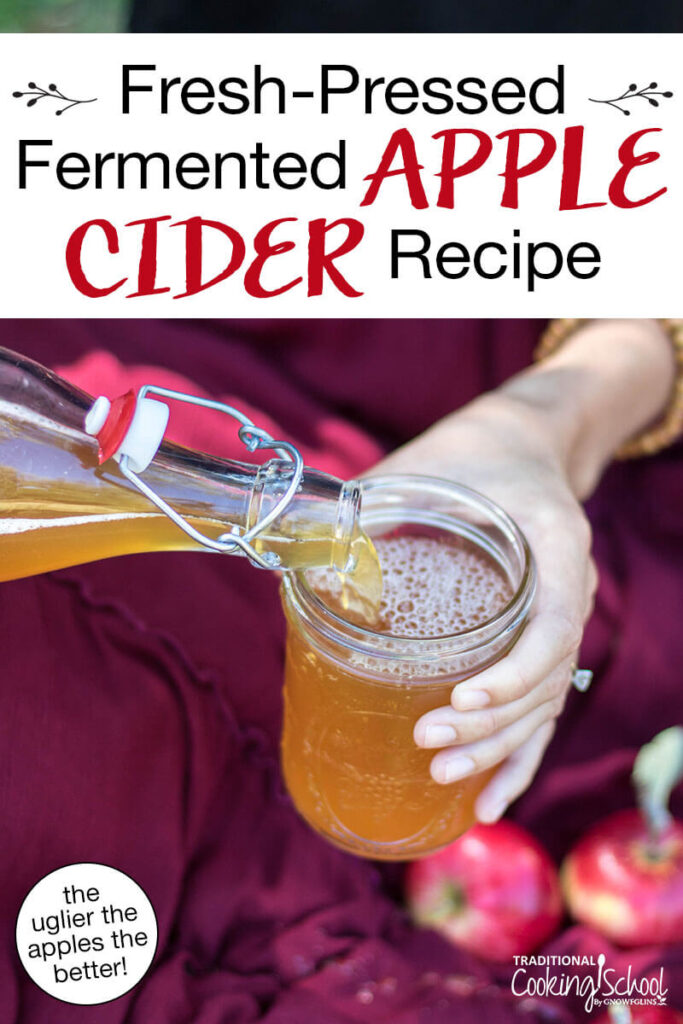
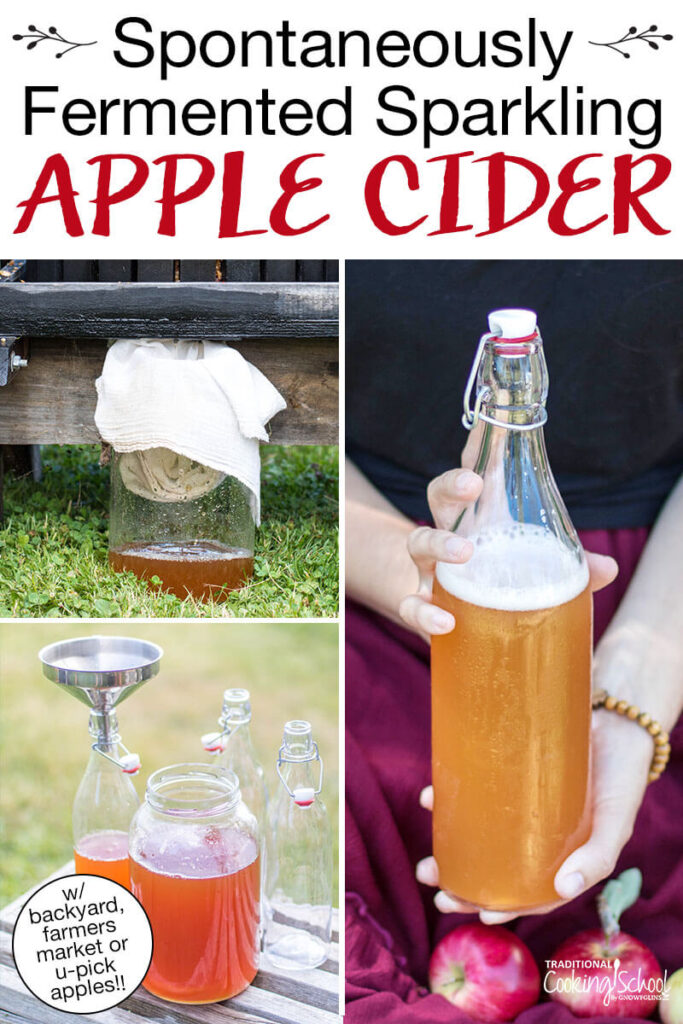
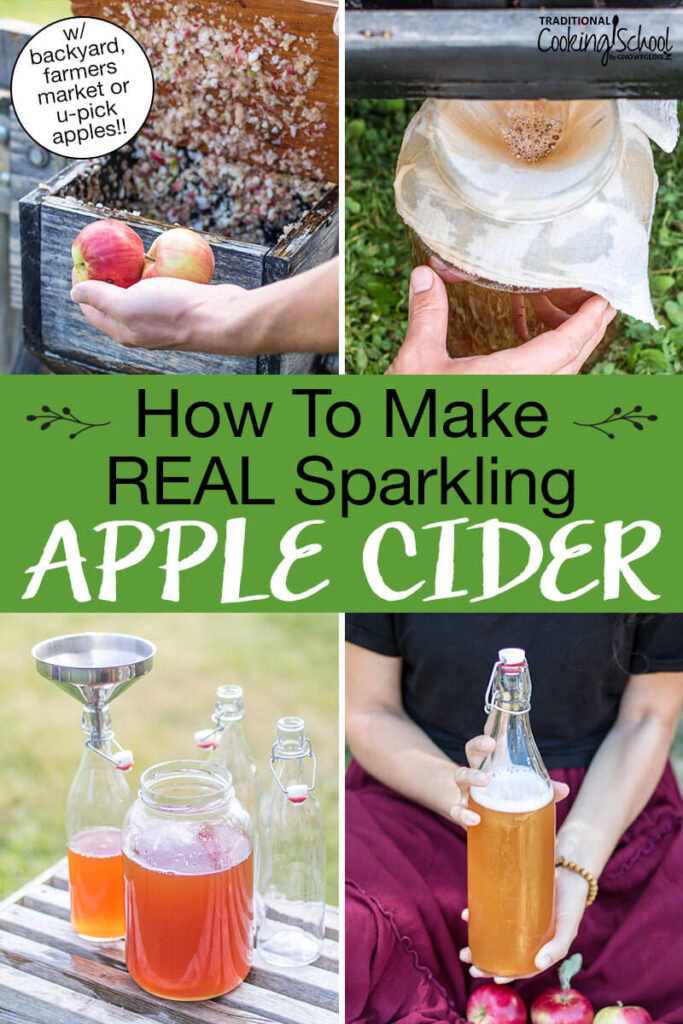
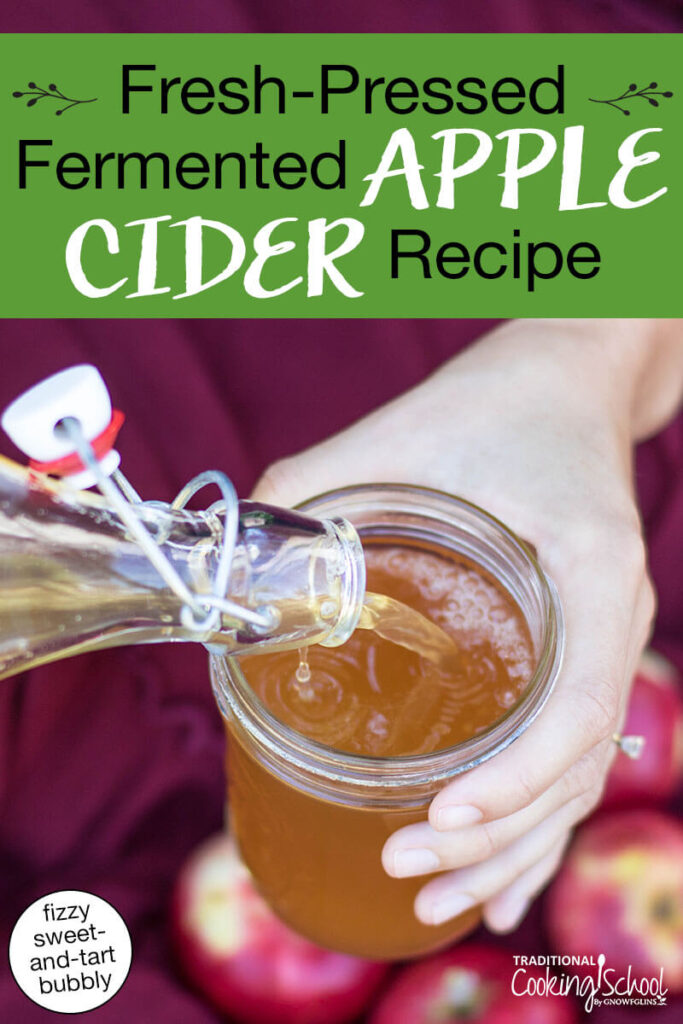
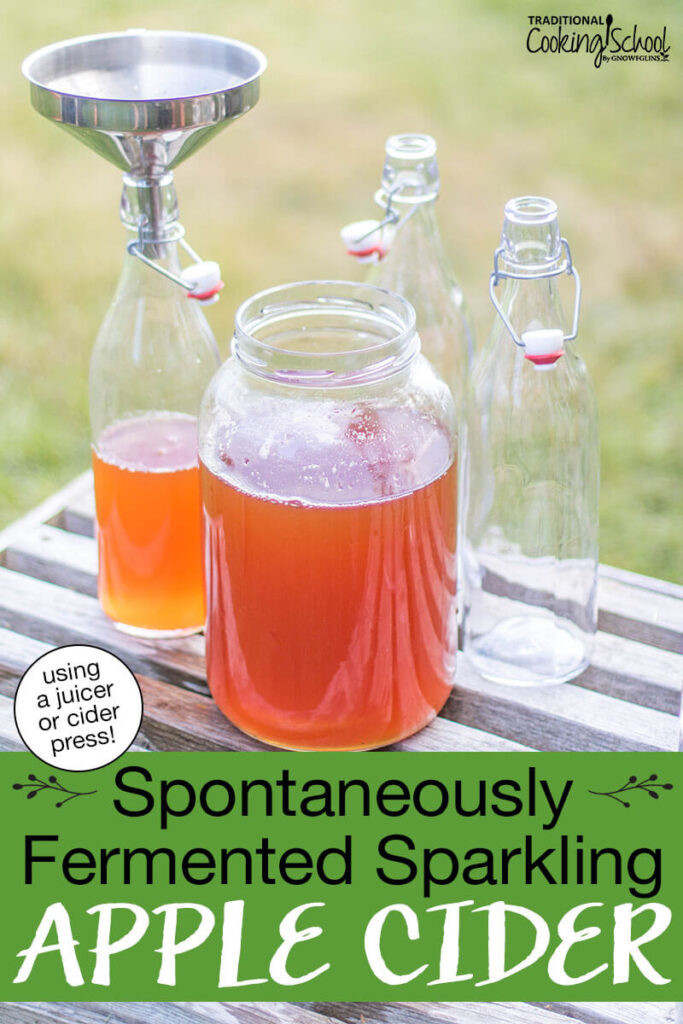


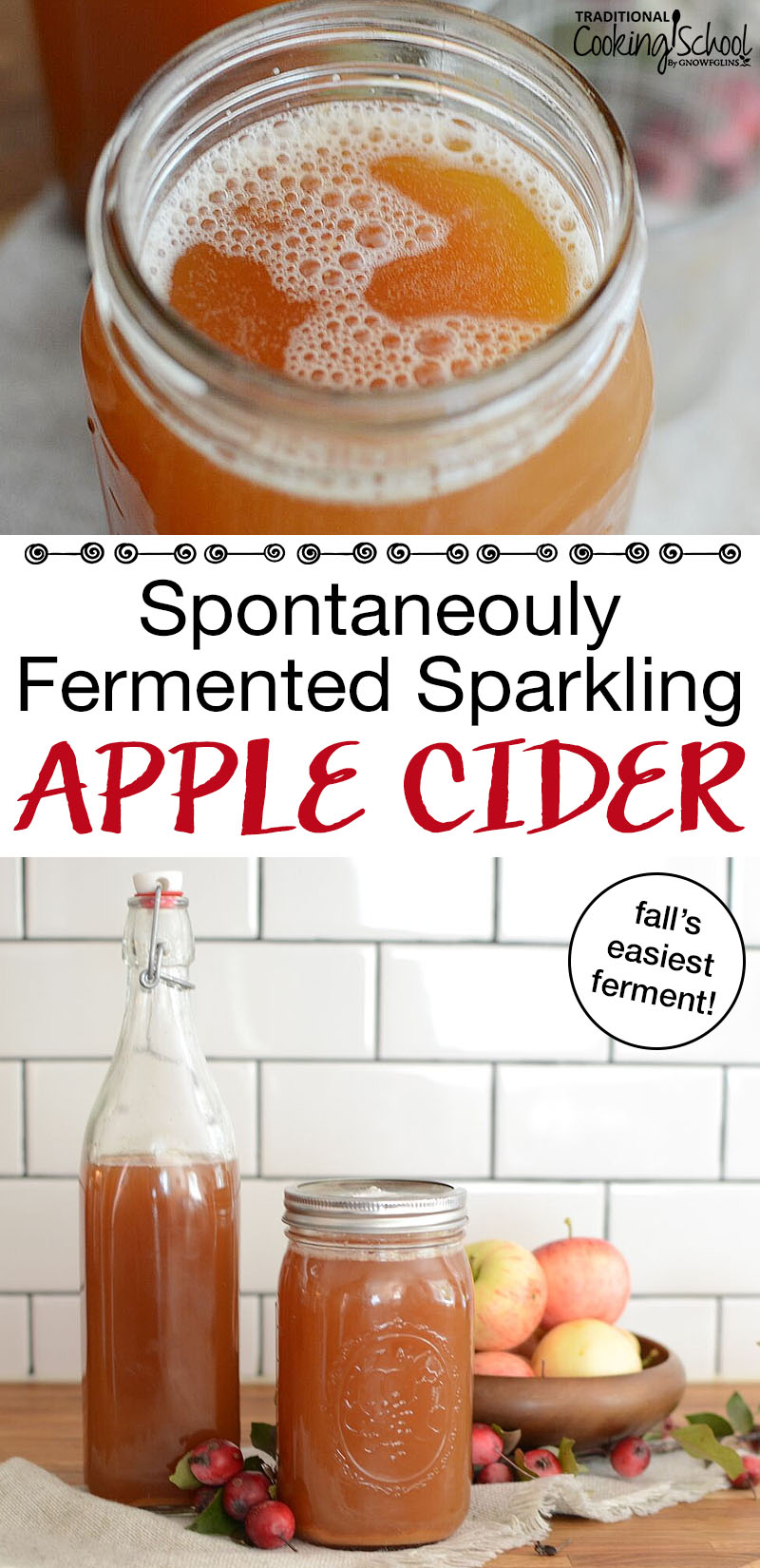
Sounds yummy!
I blanched apples for freezing, quickly boiled the peels (no ice bath after on the peels) added sugar to the water and brought to a boil. I put the cooked peels and the uncooked cores in jars and added the apple syrup and extra water. Covered with cheese cloth and is presently sitting in my cupboard. I soaked the apples in salt water before all of this. Have I OVER CLEANED my apples? If so can I add yeast to help for fermentation?
Yum! I can’t wait to try this!
you said “as the yeasts and bacteria get to work”. are we to add yeast??
Nope! There is no yeast listed in the recipe. The apples have natural yeasts (and bacteria) on them, as long as they’re organic and you don’t over-wash them.
How do you keep it from “going too far”? If 2 to 4 days is all you need, how do you stop it from turning sour, or into alcohol? Does the refrigeration “stop” it?
Yes, refrigeration stops fermentation — as with any ferment (kraut, kombucha, kefir). After a couple of days, taste it and see if it’s the level of sweetness and fizz you like. If you want more fizz, go another day or two. Unless your house is really warm, it won’t begin to ferment into alcohol for at least a week, but most likely longer.
I wonder – does the canned cider retain its fizz?
Not really. It’s still tasty, but not fizzy or fermented after canning.
Wardee, I do not have a juicer… what about putting the apples in my Vitamin and then ferment??
Hi Renee! Sorry, but that won’t work unless you can figure out a way to strain the pulp. Whether using a cider press or juicer, the juice is pressed out of the apples. There is no pulp leftover.
How long would this keep in the fridge?
We’ve had a batch taste amazing after being in the fridge for almost a year. It was awesome!
Can I use half gallons instead of quart jars?
I’ve had some last up to a year before we drank it.
Thanks for the reminder! I actually did this one time on accident, by failing to refrigerate “real” apple cider I had purchased at the farmer’s market. When I drank it, I was pleasantly surprised at the fizziness. It is so good!
What a happy accident!
The same thing just happened to me. I was wondering if I can keep adding a bit of it to fresh batches of cider to sort of “seed” it with the proper bacteria to keep making more. If so – do you know what ratio of fermented to fresh cider I should use? My hopeful experiment may have been thwarted, though, because one of my children actually stuck it in the freezer yesterday and I found the jug frozen solid! Keeping my fingers crossed it can be saved or recreated. It was PERFECT!
I specifically look for unpasteurized cider for this reason. Also, they actually can and will start to ferment in the fridge. It is a slower process, but from my experience it can still turn cider somewhat alcoholic in a few months. I stumbled upon some unpasteurized pear cider that I purchased frozen, thawed in the fridge, and just took a sip of straight from the bottle before finding it was terribly sweet. I left it in the fridge for the next two or three months, and when I went to try it again, it had changed in terms of consistency and taste. It was less thick, fizzy, and very tangy. It sort of reminded me of a sour cherry soda, and was generally just much tastier than ti had been prior. I poured out 3/4 of the bottle, drank it, and felt a pretty noticeable alcoholic buzz. I discarded the remaining quarter because it was a thicker, cloudier liquid. It honestly had probably just settled and was fine, but because I figured drinking from the bottle had introduced the yeast that kick started the fermentation, I wondered what other bacteria might have been introduced. I’m not sure why I thought it would have sank to the bottom – that’s probably crazy and if any part of it was dangerous then all of it would have been, and vice versa – if any part was safe, again, all of it probably was, too.
May I ask how long your friend water bath cans her cider?
May I ask how long your friend water bath cans her cider?
Yes! As long as the jar/bottle has a rubber seal to allow carbonation to build up!
It can be put in any size jars that have a sealing lid and/or swing top bottle.
Thanks. Answers my question. I have a few gallon jars but they were pickle jars, so I’m thinking they won’t work. Can’t wait to try this, this weekend. I’m excited.
awesome, cant wait
quick question please, I dont have a juicer, I wonder if with magical bullet blender would be okay even the apple juice will have pulp since its not a juicer, please advise, thanks
Hi, awesome
Wonder if I use the blender since I have no juicer, it will be a fruit pulped skinned juice, is that okay to ferment? or I have to remove the pulp and skin from the juice?
Thanks, please advise when u get the chance
Sebastian
What about bugs? Our neighbor gives us apples, but they are always wormy. I’m sure the extra protein is good for you but it sure doesn’t sound appetizing!
“Store bought sweet cider won’t work”? I beg to differ. I don’t know what kind of cider your stores sell, but around here we buy real apple cider from the store. If you leave it long enough it WILL ferment, “natural organic bacteria” or no. Apples is apples, and nothing is really sterile. I just finished a gallon of Cold Hollow cider that turned hard between now and Thanksgiving. It was delicious. Not the first time I’ve done it. Sometimes it seems to turn more to vinegar; it must depend on what organisms get into it. But any cider will ferment if you leave it sitting. It’s the nature of the beast. If it doesn’t just go plain bad, it goes hard. It doesn’t just stay static. And refrigeration doesn’t stop it. Mine turned in the fridge. Maybe cool temps slow the process down, but they don’t stop it. And if ancient Yankee tradition is correct freezing the cider makes it turn much more powerful (I admit I don’t know how that works, but it has been done that way for a long time in New England).
I learned this method from a bunker maniac. He would make the cider, and then freeze it. Removing the water, thawing, freezing. He did this thrice if I remember correctly. Brought the water content down, which raised the sugar concentrations. Then the yeast would feast again. Pretty strong stuff, akin moonshine.
In New England we called it
Apple Jack !
NY doesn’t allow cider anymore since about 20 yrs ago
Only pasteurized, therefore dead. No fermenting happening, just rotting. Spoiled cider like spoiled milk.
So this is a recipe for non-alcoholic cider, but leaving it to ferment longer will eventually make it alcoholic, is that correct?
Little research has been done on the effectiveness of apple cider vinegar for heartburn relief. Consequently, it is difficult to say how apple cider vinegar remedies heartburn. It appears that the acid content in vinegar somehow tells the stomach to stop producing more acid. Perhaps, in that way, apple cider vinegar is like the prescription medications that “shut down” the stomach’s acid pumps to stop heartburn.
So… I have been given about a gallon of apple juice from my Dad and it has already goen slightly fizzy so thinking of doing this. However another result from google says that it could cause stomach upsets…. I’m confused how it is safe… but also happy to find this recipe.
Can I use a food mill? Do you need the skins to remain?
Can you use pickle pipe lid tops so you don’t have to burp them? I get so nervous about “burping” – waiting to long and it building too much pressure (I’ve heard they can explode) or doing it to often. Just curious if the pickle pipe lids would work or if need to do a air tight lid like the mason jar top. Thanks!
Wondering if you have ever added cinnamon or spices to this recipe?
Tried this recipe and its really amazing.
I tried this recipe. Burped everyday for 4 days and found a thick layer of mold on top. I scooped it off and poured the rest through a sieve. Is it ok to drink?
GREAT to find this recipe on the web thanks
I also have been doing this for years.
i do add vanilla extract, spices and herbs (lemon verbena!!)
apple jack is potentially harmful to the body, if you go onto youtube you will catch up on the controversy.
I would like to know whether to let the sediment go to the bottom of the jug and not drink it (like w lees in wine making) or to keep swirling it in?
thanks for your response Lindsey
How long will this last refrigerated? Made this and LOVED it. I have many many more apples to juice.
Can I use a Scoby from my Kombucha to make fermented apple juice? Then check the pH after a few days to see if the acid is low enough to consume.